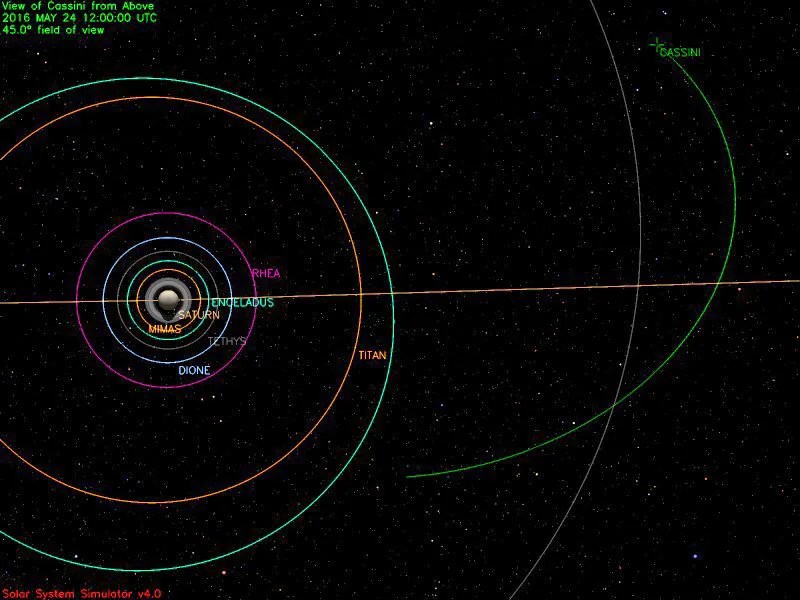4 min read
Cassini is orbiting Saturn with a period of 31.9 days in a plane inclined 36 degrees from the planet's equatorial plane. The most recent spacecraft tracking and telemetry data were obtained on May 25, using one of the 34-meter diameter Deep Space Network stations in Australia. The spacecraft continues to be in an excellent state of health with all of its subsystems operating normally except for MIMI at present, and the instrument issues described at http://saturn.jpl.nasa.gov/anomalies .
Cassini continued climbing outbound from Saturn, slowing until it reached apoapsis passage, the "top of the hill," on Friday. Most of its activities were controlled by the onboard command sequence S94. Meanwhile back on the home planet, Sequence Implementation Process teams, with members on two continents, continued working on the sequences that will control Cassini's future activities. The S95 sequence begins executing on June 26, and S96 goes active on September 8. Development activities for the ten-week-long S97 are right on schedule.
Wednesday, May 18 (DOY 139)
Cassini's Cosmic Dust Analyzer (CDA) dictated spacecraft pointing for eight hours, while the spacecraft was out near the high point in orbit, to make observations of exogenous dust -- grains coming in from outside the Saturn system.
Cassini's project scientist gave an evening presentation on the JPL campus entitled “Going Out in a Blaze of Glory: Cassini’s Grand Finale” to an audience of more than 100 employees as part of the JPL Stories Program.
Thursday, May 19 (DOY 140)
The Imaging Science Instrument (ISS) led a 90-minute routine monitoring observation of Saturn's largest satellite Titan, while the Composite Infrared Spectrometer (CIRS) and the Visible and Infrared Mapping Spectrometer (VIMS) participated. The planet-like moon was about 4.2 million kilometers away from the spacecraft. Next, ISS had the spacecraft turn and point close to Saturn for one hour, an observation in the satellite orbit campaign looking for small objects; CIRS and VIMS again rode along. Right on the heels of this, ISS made a two-minute storm-watch observation on Saturn. This trio of observations was repeated on Saturday.
Cassini's deputy project scientist, along with the program manager, gave a presentation to the president of the Italian Space Agency, Agenzia Spaziale Italiana (ASI). ASI has been a partner in the Cassini mission since its very beginning.
Friday, May 20 (DOY 141)
The Magnetospheric and Plasma Science (MAPS) instruments continued gathering in-situ data on the local environment today. Midday, the spacecraft passed through apoapsis in its orbit of Saturn, marking the beginning of its orbit #236. It had reached an altitude of 3.27 million km from Saturn, having slowed to 6,749 km per hour relative to the planet.
Saturday, May 21 (DOY 142)
CIRS stared at the sunlit side of Saturn's rings for 10 hours today, obtaining thermal-infrared spectral data for use in studying ring-particle composition. ISS, VIMS, and the Ultraviolet Imaging Spectrograph (UVIS) rode along. The viewing geometry from Cassini, out near apoapsis of its inclined orbit, is illustrated here.
An image featured this week shows Cassini's view of Saturn when the spacecraft was in a lower-inclination orbit about three months ago: /resources/17376 .
Sunday, May 22 (DOY 143)
Following time-tagged commands that were uplinked the day before, today Cassini turned and fired its small rocket thrusters for 23 seconds. This Orbit Trim Maneuver (OTM)-450 provided the planned change in velocity of 27 millimeters per second to the spacecraft, setting up for the Titan T-120 flyby on June 7.
Monday, May 23 (DOY 144)
An alarm went off at 3:15 in the morning Pacific time, alerting the flight team that Cassini's Magnetospheric Imaging Instrument (MIMI) was having a problem. Indications in telemetry from the spacecraft showed that MIMI might have experienced a rare single-event upset caused by an ionizing particle hitting the wrong place in the instrument's computer memory. The MIMI team began preparing commands that would investigate the problem by reading out the instrument's memory and having it turn off until at least Sunday.
Tuesday, May 24 (DOY 145)
Saturn solstice occurs one year from today. As Saturn orbits the Sun once every 29.7 Earth-years and its seasons progress, summer will begin in its northern hemisphere on that day. The current phase of Cassini's extended mission is named the Solstice Mission in reference to that epoch.
The Deep Space Network communicated with and tracked Cassini on seven occasions this week, using stations in California and Australia. A total of 4,939 individual commands were uplinked, and about 1,045 megabytes of telemetry data were downlinked and captured at rates as high as 142,201 bits per second.








